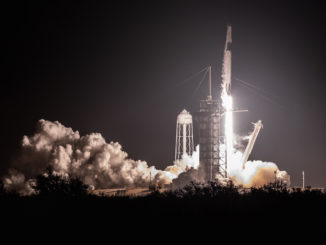
Russia launched an unpiloted Progress cargo freighter Sunday from Kazakhstan, on course to deliver 2.7 tons of food, fuel, water, and supplies to the International Space Station before hauling away a no-longer-needed section of the outpost later this year to clear the way for a new laboratory module.
The Progress MS-16 cargo ship blasted off from the Baikonur Cosmodrome in Kazakhstan aboard a Soyuz-2.1a rocket at 11:45:06 p.m. EST Sunday (0445:06 GMT; 9:45:06 a.m. local time).
The kerosene-fueled launcher quickly disappeared into a soupy layer of clouds, but live video from on-board “rocket cams” showed the Soyuz climbing through the atmosphere before shedding four first stage boosters and an aerodynamic shroud that covered the Progress spacecraft during the first few minutes of flight.
The Soyuz later jettisoned its core stage and ignited a third stage engine to finish the job of placing the Progress MS-16 supply ship into a preliminary orbit.
Liftoff of a Soyuz rocket from the Baikonur Cosmodrome in Kazakhstan with more than 2.7 tons of fuel, food, water, and supplies for the International Space Station. https://t.co/hB7ZqpePbR pic.twitter.com/1sHI1r7hcq
— Spaceflight Now (@SpaceflightNow) February 15, 2021
The automated cargo carrier separated from the Soyuz third stage and unfurled solar panels and navigation antennas, beginning a two-day pursuit of the space station that will culminate in a docking with the space station’s Pirs module at 1:20 a.m. EST (0620 GMT) Wednesday.
The Progress MS-16 spacecraft is loaded with around 5,424 pounds, or 2,460 kilograms, of cargo and supplies for the space station and its seven-person crew, according to Roscosmos, the Russian space agency.
The freighter’s payload includes about 3,086 pounds (1,400 kilograms) of dry cargo packed inside the Progress spacecraft’s pressurized compartment. There’s also 1,322 pounds (600 kilograms) of propellant to be fed into the space station’s Zvezda service module propulsion system, along with 926 pounds (420 kilograms) of fresh water and 89 pounds (40.5 kilograms) of pressurized gases to supplement the space station’s breathable atmosphere.
The Russian Progress MS-16 cargo freighter has separated from its Soyuz launcher and deployed solar panels after a successful ascent into orbit from the Baikonur Cosmodrome, taking aim on the International Space Station for docking Wednesday. https://t.co/hB7ZqpePbR pic.twitter.com/vtfLBy6vrE
— Spaceflight Now (@SpaceflightNow) February 15, 2021
The Soyuz rocket’s liftoff Sunday marked the 77th launch of a Progress supply ship to the International Space Station since 2000. The previous Progress cargo ship, Progress MS-15, undocked from the space station Feb. 9 and made a destructive re-entry into the atmosphere, getting rid of trash and clearing the way for the arrival of fresh cargo delivery.
The Progress MS-16 spacecraft is also carrying equipment to help cosmonauts detect and patch leaks on the space station, plus Russian biomedical experiments and a research payload to study obtaining food and oxygen from algae in microgravity, Roscosmos said.
The supply ship will remain at the space station until July, when the Progress is scheduled to depart with the Pirs docking compartment in tow. The Progress MS-16 will guide itself, along with the disused Pirs module, back into the atmosphere to burn up at the end of its mission.

The Pirs module has served as a docking port and an airlock for cosmonauts on spacewalks since 2001. A similar module named Poisk serves a similar function, and will remain at the space station.
The removal of the Pirs module clears a docking port on the Zvezda service module, the central hub of the space station’s Russian segment, for the arrival of the long-delayed Nauka laboratory later this year after launch on a heavy-lift Proton rocket. The Nauka lab module will be the largest addition to the Russian segment of the station since 2000, when Zvezda itself was launched.
Email the author.
Follow Stephen Clark on Twitter: @StephenClark1.



